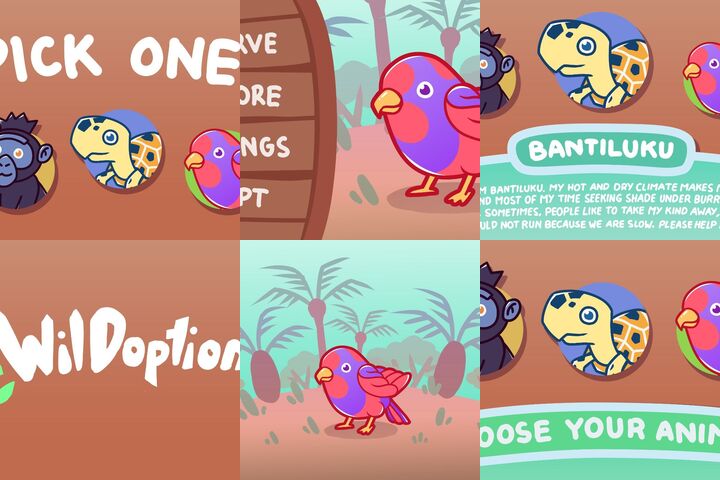WilDoption
The Problem
There’s a positive attitude towards conservation but very limited opportunities to translate and harness that attitude into a behavior. Conservation is also exclusive, does not feed on a larger audience, perceived as a complex and serious issue, which failed to attract a category of demographic that may just be an untapped resource and possibly the next generation of wildlife conservationists. Non-governmental organizations (NGOs), big or small, often rely on donations from the public to fund conservation programs. In 2014, both World Wildlife Fund for Nature (WWF) and The Nature Conservancy, the world’s largest conservation NGOs, reported that their largest revenues came from public donations, accounting for 55% and 37% respectively (Verissimo et al., 2018). This means that the success of facilitating public donations and crowdfunding efforts significantly impacts conservation outcomes. However, mobilizing a larger audience with positive attitudes toward wildlife conservation to channel the attitude into a behavior proves to be challenging for NGOs without an attractive means to facilitate the crowd-funding. This will be the problem to be addressed with our intervention.
Our Proposal
The intervention we propose would address several predictors of behavior change and specific behavior changes in conservation. We propose an intervention in the form of a digital game that illustrates the adoption of virtual pets created based on real endangered wildlife. This approach will create a fun and educational platform, which could also facilitate opportunities for users to fund relevant conservation efforts (Sandbrook et al., 2015). Predictors of behavior change being addressed here are (1) awareness and in turn, personal norms, (2) attitude towards the behavior, and (3) perceived behavior control. We address the first two predictors with fun and engaging educational games that can be played throughout the simulation. Additionally, we also aim for specific behavior in the realms of environmental activism, non-activism behaviors, behaviors direct to species or project, and pro-organization conservation behaviors. Naturally, the approach of the game will be persuasive and frame crowd-funding as a fun, easy, and enriching opportunity to be digital conservationists, thereby shifting the attitude towards generous giving. Both awareness and attitude will be facilitated by an opportunity to directly give monetary support for the efforts done by relevant NGOs (in the form of in-game purchases), which in turn creates an extent of control for users to engage in behavior change.
We Assume that...
Increased awareness about conservation issues among young generations due to readily available internet, but still low contribution to real conservation problem.
Conservation NGOs have mainly relied on big donor agencies and philanthropists, and rarely leverage the willingness of young generation to contribute.
Small conservation NGOs have notably experienced difficulties in funding and finding more sustainable donors, while they lack the chance to raise awareness and promote their conservation work.
Donation systems for conservation is often carried out in boring ways through membership and email exchanges.
Many behavioral change initiatives focus on enriching knowledge and improving attitude, but are still inadequate addressing specific behavior.
Young generation uses phones mainly for social media and games. Our solution uses games that will be easily downloadable and act as more fun learning platform.
Many threatened yet overlooked species have suffered little conservation attention, even though they face similar threats.
Constraints to Overcome
Despite many efforts to combat biodiversity loss worldwide, many conservation projects overlook the importance of strategically addressing human behaviors. These efforts would be collectively more effective if conservation organizations are more successful in mobilizing larger audiences and link their activities directly to conservation actions. By strategically engaging wider audiences and focusing on behavior change, a conservation organization can direct a collective behavior toward actions that help to reduce biodiversity threats. We would address the clear gap in opportunities for engaging the public in conservation actions that lead to these behavior changes, especially for local conservation NGOs that suffered funding difficulties for neglected yet threatened species.
Current Work
Our team’s primary work upcoming months include both aspects of project management and game development. The former consists of managing the project’s timeline, resources, and members, divided into planning and execution. The latter includes designing the flow of the game, the main gameplay, finding the appropriate art style, extensive research for the more accurate factual aspects about the ecology and conservation of the species, as well as creating a donation system and feedback mechanisms that would be suitable for both the game (users) and conservation NGOs. Naturally, we will also establish collaboration with conservation NGOs that have been working on each species featured in the games.
Current Needs
In order to make the concept a reality, this project needs both resources and skills. We need a programmer who understands the use of game engine tools such as Unity and will be able to implement multiplayer features into the game. In addition, we also need an animator that understands the bone animation tools such as Spine or Unity Animator and will be able to export them to Unity. After the initial development, we will also look into searching for members that understand social marketing and web design to ensure the successful execution of the game.
